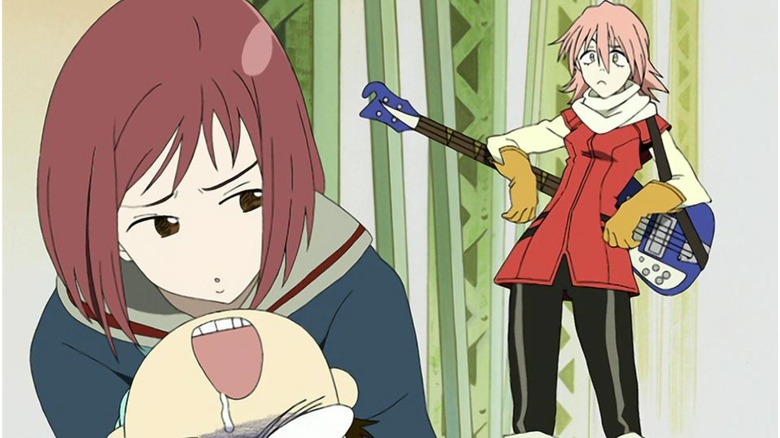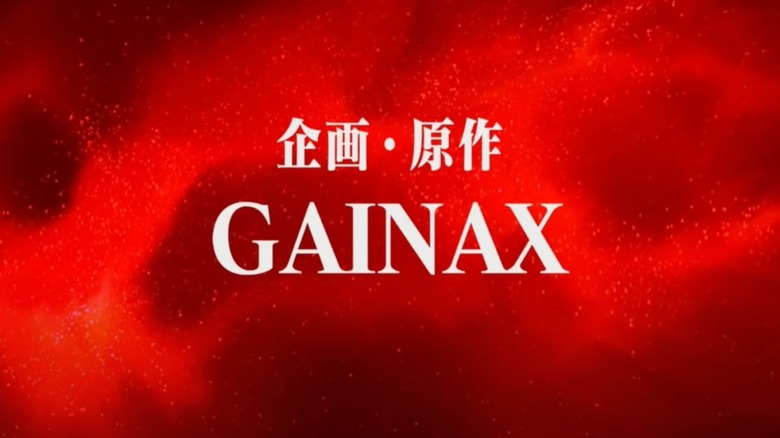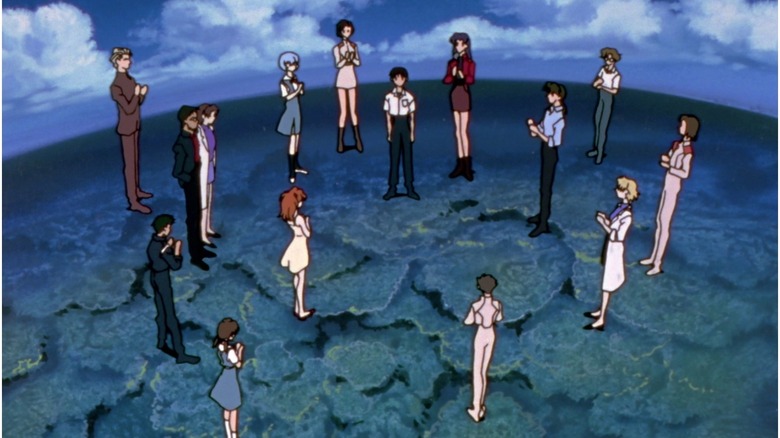The Grim Inspiration That Connects FLCL And Evangelion
"FLCL" and "Neon Genesis Evangelion" are anime classics, both of which pay homage to and deconstruct the mecha genre. The two are both famous for their surreal animation, but while "Evangelion" is introspective, kaleidoscopic, and nightmarish, "FLCL" is bonkers and revels in its rejection of formal sense. Even the characters are similar: Naota Nandaba from "FLCL" is a dead ringer for Shinji Ikari in "Evangelion," Mamimi Samejima has the same emotional disaffection as Rei Ayanami, and Haruko Haruhara feels like someone threw Misato Katsuragi and Asuka Langley Soryu in a blender. According to "FLCL" director Kazuya Tsurumaki, the similarities between the shows come from a common cultural root.
Studio Gainax spotlight
Both "Evangelion" and "FLCL" were produced by Studio Gainax. Founded in 1984, the studio was notable for being founded by anime fans. At the height of its creative prowess, Gainax was one of the biggest studios in anime and even influenced western animation like "Avatar: The Last Airbender." One of the seven founders was Hideaki Anno, who first conceived of "Evangelion"; the series was influenced as much by his anime fandom as it was by his depression and anxieties. Before directing "FLCL," Tsurumaki was an assistant director on "Evangelion."
When Tsurumaki visited the American Otokon Convention in 2001, he detailed how these anxieties bleed into Gainax's output. After confirming that Shinji was based on Anno himself, a fan asked Tsurumaki why "so many Gainax series feature very anxious, unhappy young male protagonists with no parents." His answer? "The directors at Gainax are all basically weak, insecure, bitter, young men. So are many anime fans. Many Japanese families, including my own, have workaholic fathers whose kids never get to see them. That may influence the shows I create."
It's a deeply honest and self-conscious answer. All of the main characters of "Evangelion" were damaged by their relationships with their parents, which is one of the series' many Freudian themes, and none of them are sure of how to coexist with others because of that. In "FLCL," for example, Naota's father, Kamon, is an anime obsessive and his immaturity damages their relationship; Naota looks up more to his absent brother than Kamon.
Light in the dark
Both "Evangelion" and "FLCL" are coming of age stories which filter the problems of teenage boys through mecha and anime tropes. Many viewers rejected Shinji for his supposed cowardice and whininess. As for Naota, what young boy can't relate to having a bump on his body stick up and not go down after he meets a pretty girl?
A trademark of "FLCL" is fourth-wall breaking; in one such moment, Haruko tells Naota, "I'm an illusion of your youth, a manifestation of the feelings in your adolescent heart!" Naota's response? "Where'd you get that line, anime?" Indeed, the character arcs of "FLCL" show that you can't cling to such illusions forever. Haruko returns to space to follow her love, Atomsk the Pirate King; Mamimi leaves town to pursue a photography career; and Naota looks like he might finally develop a healthy relationship with his classmate Eri Ninamori.
"Evangelion" has ended four different times: "Neon Genesis Evangelion" Episode 26, "Take Care Of Yourself;" feature film "The End Of Evangelion;" the final chapter of Yoshiyuki Sadamoto's "Evangelion" manga, "Setting Off;" and the film "Evangelion 3.0 + 1.0: Thrice Upon A Time." Yet, all the endings have the same message: You can only find happiness by embracing life and yourself in all their beauty and ugliness. In the aforementioned Q&A, Tsurumaki said, "[Anno] thought that working on 'Eva' could help him to change." Anno clearly hoped that watching it would do the same for its viewers.


